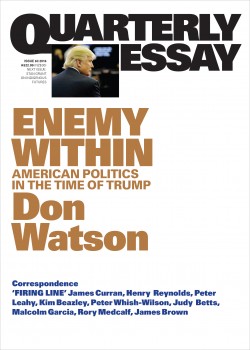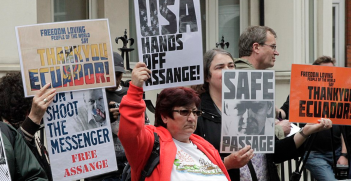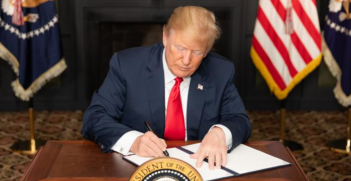American Politics in the Time of Trump

Every four years the people of the United States of America choose the person they think most likely to keep them free and safe; and to decide what their country’s interests are and how they should be pursued. Among those interests are the interests of national security, which means they are in effect choosing the person who will decide who should be spied upon, selectively bombed or invaded, and who left alone; who should live and who should die; if life on the planet should continue or pretty much cease. Well, if they don’t do it, who will?
Actual voting is for American citizens only: while recognised as people by the US Supreme Court, corporations wholly or partly owned by foreigners cannot vote, but may contribute as much money as they like to the candidate of their choice. On election day, across the country about 120 million of the 220 million who are eligible turn out to vote, some of them with marvellous knowledge of affairs, and some in bottomless ignorance of everything; some with the tiny part of the brain that enables them to reason and judge, and some with evolutionary accumulations of instinct and fear lurking in the other 98 per cent of it.
“We have never been just a collection of individuals or a collection of red states and blue states,” Barack Obama told the crowd in Chicago the night he was elected in 2008. The words were just the thing for the occasion, of course, but every day since has given the lie to them. Obama was doing in this speech what all the best American speeches do: laying the stress on the egalitarian and the communitarian, as if the qualities recommended by the Reverend John Winthrop for his Christian colony of Massachusetts 400 years ago remain the qualities that set the United States apart. But, of course, if any country is a collection of individuals it is the United States. Otherwise all that talk about rugged individualism and the American Dream, and doing it my way, would be so much hogwash. It has to be a collection of individuals or advertising wouldn’t work. Not just a collection, maybe, but mainly that, especially in their minds.
Americans are divided on party lines as never before. The lines between red and blue states, counties and communities, have never been so clearly drawn. Of course, there are purple states as well as red and blue ones: ‘battleground’ states, meaning states where the contest is tight, where the ducks are; the ducks being the ones hunted by the candidates, the relative handful of people who decide those questions that a presidential election decides for the world. In purple states the differences that divide one state from another divide the state itself. Check the electoral map of Pennsylvania: in 2012 Obama won in just 12 of that state’s 67 counties, but he took the state and its 20 electoral votes because he took Philadelphia and Pittsburgh. Since 2008, the whole country has come to resemble a battleground, albeit one, like the Somme for long periods, in stalemate. And 2008 was another age: back then there was only one red party and one blue party. Now there are two of each.
The United States is a miracle of an ever-evolving pluralist democracy and, in the absence of any other candidates for the role, still the last great hope of humankind. It is a wonderland of invention, a marvel of freedom and tolerance, and by most measures the greatest country on earth. “We are, and always will be, the United States of America,” Obama said. He surfed on the cheering, and in that moment some of us almost joined in. God bless them, we almost said. Eight years later he was right.
But to think of the United States as a place, or even as a state, is probably the first mistake. It is not one but many places. While their political leaders will forever say there is more to unite than divide them, in fact the citizenry is divided by cultural, historical, racial, ethnic and ideological differences that every day—every minute in the media—make the platitudes laughable. Democrats say there is more to unite them—as they divide them with identity politics. Republicans chide the Democrats for their identity politics while they dog-whistle to bigotry and preach nostrums they learned at the feet of Ayn Rand.
Some of these tears are visible and categorical: in the suburbs and the cities, for instance, where the dividing lines are so abrupt you can find yourself in a different world in the space of a few absent-minded steps. Some are invisible or subterranean: on the highways you cross them, like songlines, without knowing. There are fractures going back to the Civil War and beyond, forces for good and ill generated in now forgotten times that nevertheless impose themselves, even as the politicians declare their “boundless confidence in America’s promise” and implore the people to think of tomorrow. The state has been so deeply fractured for so long that only national crises, real or imagined, and their associated eruptions of fear and loathing of an external enemy can bring it together. We talk of Americans wrapping themselves in the flag: they bandage themselves in it. The yard signs of the election season are polite disguises for the underlying truth: the United States is a concatenation of sulky tribes; provincial, ignorant and seething with ambition, frustration and resentment.
Don Watson is the author of many acclaimed books, including Caledonia Australis, Recollections of a Bleeding Heart, American Journeys and The Bush. His previous Quarterly Essay was Rabbit Syndrome.
This is an edited extract from Don Watson’s Quarterly Essay 63, ‘Enemy Within: American Politics in the Time of Trump’, published this month, www.quarterlyessay.com
It is published with permission.





